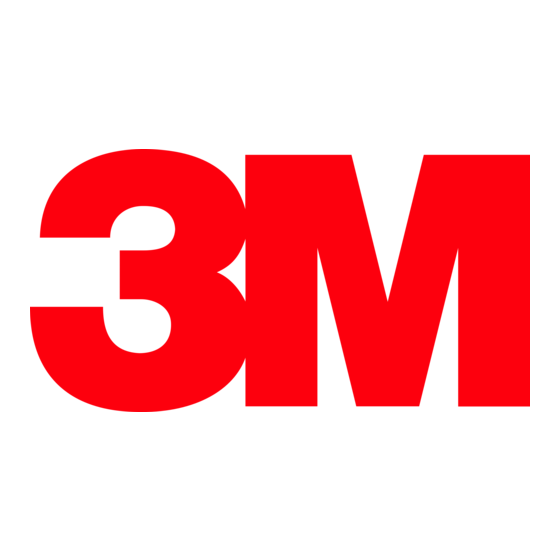3M 6000 Інструкція користувача - Сторінка 10
Переглянути онлайн або завантажити pdf Інструкція користувача для Респіраторний продукт 3M 6000. 3M 6000 15 сторінок. Half facepiece respirator
Також для 3M 6000: Посібник користувача (4 сторінок), Інструкція користувача (16 сторінок), Технічний паспорт (5 сторінок), Інструкція з експлуатації (2 сторінок), Інструкція з експлуатації (8 сторінок), Інструкція користувача (2 сторінок)

Negative Pressure User Seal Check with Filters 7093/7093C
1. Using hands press or squeeze filter covers toward facepiece and inhale gently. If you feel the facepiece collapse slightly and pull closer to your face
with no leaks between the face and facepiece a proper seal has been obtained (Fig. 14).
2. If faceseal air leakage is detected, reposition the respirator on your face and/or readjust the tension of the straps to eliminate the leakage and
recheck seal.
If you cannot achieve a proper seal, DO NOT enter contaminated area. See your supervisor.
Negative Pressure User Seal Check with Dual Airline
1. Disconnect airline hose from air control valve.
2. With breathing tube still connected to the air control valve inhale gently. If you feel facepiece collapse slightly and pull closer to your face with no
leaks between the face and facepiece, a proper seal has been obtained.
3. For 3M™ Combination Dual Airline where cartridges or filters are attached, perform user seal check as described under the appropriate cartridge
or filter that is being used.
4. If faceseal air leakage is detected, reposition the respirator on your face and/or readjust the tension of the straps to eliminate the leakage and
recheck seal.
If you cannot achieve a proper seal, DO NOT enter contaminated area. See your supervisor.
NOTE: Before assigning any respirator to be worn in a contaminated area, a qualitative or quantitative fit test must be performed per OSHA
29 CFR 1910.134, or CSA Standard Z94.4.
RESPIRATOR REMOVAL
1. Fully loosen all four head straps by lifting up on buckles.
2. Remove respirator by pulling straps over head.
FIT TESTING
The effectiveness of a respirator will be reduced if it is not fitted properly. Therefore, either qualitative or quantitative fit testing must be
conducted prior to the respirator being used.
NOTE: Fit testing is a U.S. Occupational Safety and Health Administration (OSHA), a Canadian CSA and a Brazilian BMOL requirement.
Quantitative Fit Testing
Quantitative Fit Testing (QNFT) can be conducted using a 3M™ Fit Test Adapter 601 and P100 filters such as the 3M™ Particulate Filters 2091
or 7093.
Qualitative Fit Testing
Qualitative Fit Testing (QLFT) with the 3M™ Qualitative Fit Test Apparatus FT-10 or FT-30 can be conducted using any of the NIOSH approved
particulate filters.
Respirators should also be fit tested while wearing any personal protective equipment (PPE) the wearer may use in their work environment that may
affect the fit of the respirator (e.g. hoods, hardhats, safety glasses, hearing protections, etc.).
NOTE: For further information concerning fit testing, contact 3M Technical Service at 1-800-243-4630 or a 3M location in your region. In Canada call
Technical Service at 1-800-267-4414.
INSPECTION, CLEANING, AND STORAGE
Inspection Procedure
This respirator must be inspected before each use to ensure that it is in good operating condition. Any damaged or defective parts must be replaced
before use. Do not enter a contaminated area with damaged or defective parts. The following inspection procedure is recommended.
1. Check facepiece for cracks, tears and dirt. Be certain facepiece, especially faceseal area, is not distorted.
2. Examine inhalation valves for signs of distortion, cracking or tearing.
3. Make sure that head straps are intact and have good elasticity.
4. Examine all plastic parts for signs of cracking or fatiguing. Make sure filter gaskets are properly seated and in good condition.
5. Remove exhalation valve cover and examine exhalation valve and valve seat for signs of dirt, distortion, cracking or tearing. Replace exhalation
valve cover.
6. Inspect lens for any damage that may impair respirator performance or vision.
Cleaning and Storage
Cleaning is recommended after each use.
Do not clean respirator with solvents. Cleaning with solvents may degrade some respirator components and reduce respirator effectiveness.
Inspect all respirator components before each use to ensure proper operating condition. Failure to do so may result in sickness or death.
1. Remove cartridges, filters and/or breathing tubes. The center adapter, lens and faceseal can also be removed if necessary.
2. Clean facepiece (excluding filters and cartridges), by immersing in warm cleaning solution, water temperature not to exceed 120°F (49°C), and
scrub with soft brush until clean. Add neutral detergent if necessary. Do not use cleaners containing lanolin or other oils.
W WARNING
10
(English)
